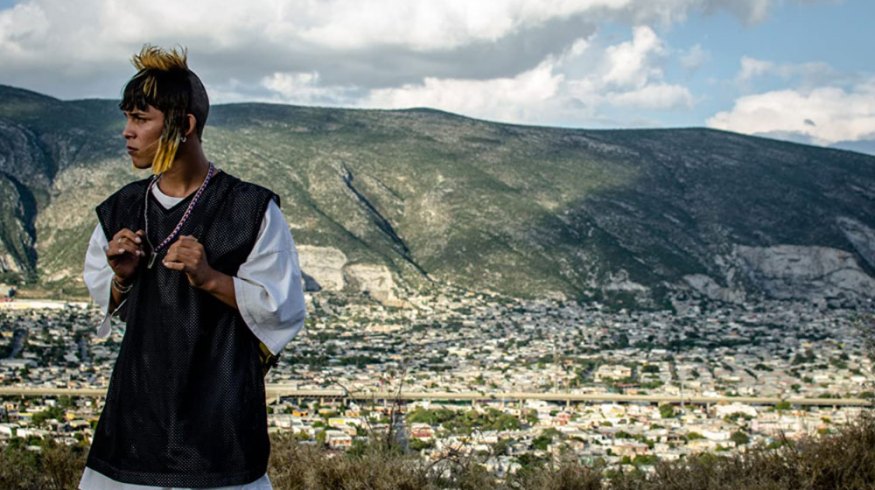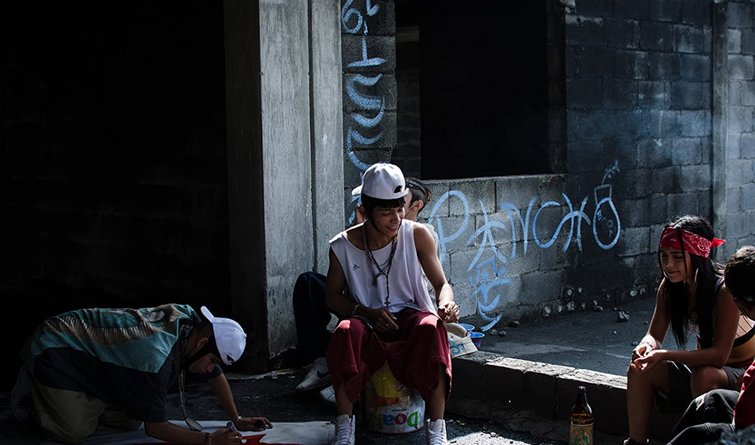
Here’s Why “Ya No Estoy Aquí” Is an Important Film About Mexico
Ya No Estoy Aquí offers an honest look into an unknown part of Mexico, exploring the impact of culture on identity and the Mexican diaspora.
In Ya No Estoy Aquí, or I’m No Longer Here for the English-speaking audience, the film follows Ulises’ journey from Monterrey to New York and back again to his hometown. It’s the story of an immigrant fleeing the country due to violence, only to find themselves living in a strange, sometimes hostile, environment. It’s a story that many Latinxs have either experienced first-hand or heard second-hand. Though the film uses tropes popular in media about Mexico—cartel violence, extreme poverty, being undocumented—it’s much more nuanced, exploring the complexities of living in Mexico’s poverty-stricken borderlands, the ties between culture and identity, and the diaspora of Mexicans and Mexican-Americans in the United States.
I highly recommend watching the film before continuing, as there are spoilers throughout, but a brief summary follows. Ulises and his friends form a group called Los Terkos—terko is slang for terco, meaning stubborn, i.e., The Stubborn Ones—and their identity revolves around the Kolombia counterculture movement that was popular in that part of Mexico in the mid- to late-2000s. In the Kolombian movement, they dance to remixed versions of Colombian Cumbia songs called Cumbias Rebajadas, or slowed-down cumbias.
In their pursuit to get the money together to buy an MP3 player full of Cumbias Rebajadas, Los Terkos have a run-in with the cartel. Ulises witnesses the cartel shoot members of a local gang, who mistake Ulises for being a co-conspirator in the drive-by because he’s holding a walkie-talkie belonging to the cartel. A survivor of the shooting threatens to kill Ulises and his whole family, which leads to the family leaving their home in a rush. Ulises is then sent to New York by his mom. In New York, he struggles to hold onto his identity, eventually ending up back home, where everything, including him, has changed.
Fernando Frías’ direction and storytelling make the film compelling, telling Ulises’ story and using Mexico’s tumultuous and ongoing war between the government and the cartels as a backdrop throughout the film, which eventually ends with citizens in open revolt on the streets. In this talk between Alfonso Cuarón and Guillermo del Toro, Cuarón says Fernando Frías is one of the most important new directors in the world. However, I also appreciated the cinematography of Damián García, who captures the beauty of the languishing neighborhoods in Monterrey’s outskirts.

However, what stuck with me the most was the film’s spot-on use of the region’s particular Spanish patois, which I’m extremely familiar with. I grew up right on the border of Mexico in Brownsville, Texas, and I spent many weekends in my youth across the border in Matamoros. Monterrey is a little under four hours west by road. The Spanish patois of northern Mexico uses a lot of slang and phrases that are highly regional and may be hard for other Spanish speakers (not from the area) to understand. Don’t get me wrong, if you speak Spanish, you can enjoy this film without subtitles, but you may miss out on certain words or phrases.
The film leans into the regional Spanish, choosing authenticity over widespread appeal, which works in their favor. I love their attention to detail in this regard, casting locals in the film to maintain a level of accuracy so authentic that it made me emotional. It’s one thing to see a fellow Mexican like Diego Luna in Rogue One: A Star Wars Story—which is, to be clear, the best Star Wars film—and it’s another to see someone who looks and speaks like you in a film. For most of the actors in the film, Ya No Estoy Aquí was their first time on camera, and I’d have never known if I hadn’t looked up the film on IMDb. The fact that it isn’t obvious upon watching is a testament to the actors’ first-hand understanding of the source material, local culture, and language.
When it comes to the setting, the film captures a specific and ephemeral moment in time in the run-down neighborhoods of Monterrey, that the outside world may have never had the chance to see. Through the lens of Ulises’ story, we see Mexico’s inequality, the struggle of being undocumented in a strange land, and the impact that culture has on our identity. Ya No Estoy Aquí cares deeply about that culture, but it also accurately portrays the complex dichotomy within every part of the Mexican diaspora. It’s that feeling of living in this country and trying to assimilate, while fearing that, by doing so, you’ll lose who you are as you inevitably drift away from your culture.
Although this film is about immigration, corrupt political systems, cartel violence, wealth inequality, and cyclical poverty, it’s also about something more that we can all relate to. Ulises’ story is about the interconnectedness of identity and culture and finding out who you are when you’re no longer here. Ulises’ identity is relative to his culture, existing solely within his group of friends, his neighborhood, and the music and particular fashion of the Kolombia movement. Without his crew and away from all he’s ever known, UIises is unbuoyed, adrift in a sea of millions of New Yorkers, as he grapples with his new reality. By moving to New York, he loses those parts of his life that form who he is, and he tries to hold onto his past to remember himself.

The one silver lining is that he meets Lin, who takes a lot of interest in him because of his distinct hairstyle and dancing. He teaches her about Los Terkos and Cumbias Rebajadas, and she begins to dress and do her hair in the Kolombian fashion, which gets the attention of her schoolmates, who invite her to a party for the first time. But, her intake of the Kolombian counterculture—at first is done in earnest—borders on cultural appropriation and exploitation by the end of their friendship. Once she’s cool and has the attention of her peers, she forgets about Ulises. As Ulises stands at the door in her last scene, Lin’s grandfather asks who’s there, and she says with finality that nobody is there before closing the door on him. For anyone that has experienced something like this, this scene is a reminder that, while others may love your culture, they won’t want you—e.g., this country may love Mexican food, but keeps deporting Mexicans.
Immediately after that rejection, he gets high and cuts off his signature hairstyle, which was the last bit of himself that reminded him of the old Ulises. Homeless and on the street, the cops arrest him for sleeping outside. Given the option between going home or fighting to stay in the states, he chooses the former, spending months in those horrible detainment facilities you hear about in the news. Months pass by until he’s deported, and on his arrival to his homeland, he stands at the funeral of one of Los Terkos, who joined up with the cartel after Ulises left. As Ulises comes full circle and goes back home, everything has changed so much that he no longer feels like he belongs there either.
His story resonates with many Latinxs because we’ve felt stuck between two places, never knowing where our home is or if we even have one. The phrase “ni de aqui, ni de alla” encapsulates this feeling perfectly, meaning “neither from here, nor from there.” For many Latinxs, the phrase is an acknowledgment of the ambivalent nature of our identities. The conclusion of the story is a reminder that, while our identity is tied to our cultural heritage in some way, it doesn’t and shouldn’t define us.
There’s no happy ending because that’s the reality of someone like Ulises. Sometimes things don’t work out, and if you’re poor, or Mexican, or undocumented, then it’s multiplied. The raw honesty is hard to swallow, but it’s no less important, helping a wider audience understand the hardships of living in Mexico and why so many flock to this side of the border.
Ulises may have chosen to go home, but for every other immigrant living in America, the choice to go back is just as hard as the one to stay. It’s up for the individual to decide where the “here” in I’m No Longer Here is. Is it where you came from or where you traveled to? For Ulises, it’s the latter, but he’s stubborn. He is, after all, a terko for life. Unfortunately, that part of Monterrey he wished he could go back to ceases to exist, leaving him adrift once again with a crisis of identity.
Ya No Estoy Aquí is available to stream on Netflix. The film is Mexico’s submission for the 93rd Academy Awards’ Best International Feature Film category. If it wins, the film would be Mexico’s second-ever win in the category after Alfonso Cuarón’s Roma, which won the award in 2019.
Cover image via Netflix.
For more behind-the-scenes articles on films and filmmaking, check these out:
- Understanding and Implementing Plot Structure for Films and Screenplays
- LGBTQ+ Films and Filmmakers That Are Making History
- Honoring the Legends Behind Chinese Martial Arts Films
- Untethered Territory: How to Shoot Films Like Quentin Tarantino
- Iconic Cinematography: Our 5 Favorite Shots from Darius Khondji





